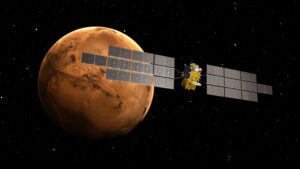Independent panel recommends delaying Mars Sample Return missions
By Jeff Foust

WASHINGTON — An independent review panel created by NASA to examine its plans to return samples from Mars endorsed the overall campaign, but recommended that the agency delay two upcoming missions to provide a more realistic development schedule.
NASA established the Independent Review Board (IRB) in August to provide an outside assessment of its overall Mars Sample Return (MSR) campaign, which started with the launch of the Mars 2020 mission in July. That mission’s Perseverance rover will cache samples of Martian rock and soil that will be returned to Earth no earlier than 2031 by two subsequent missions that NASA is planning in cooperation with the European Space Agency.
The board, in a report released Nov. 10, supported the overall effort. “We unanimously believe that the Mars Sample Return program should proceed,” David Thompson, former chief executive of Orbital ATK and chair of the board, said in a call with reporters. “We think its scientific value would be extraordinarily high.”
However, he added, “Mars Sample Return is an extremely ambitious, technically demanding and operational complex program.” The board provided 88 findings and recommendations to address the scientific, technical and programmatic issues they found with the approach.
Those included extending the schedule and increasing the cost of the program. The current MSR plan calls for launching a Sample Return Lander, led by NASA, and an Earth Return Orbiter, led by ESA, in 2026. The lander would collect the samples gathered by Perseverance and launch them into Mars orbit, while the orbiter would capture that sample container and return it to Earth.
“Since the current development schedule necessary to achieve the 2026 launches were judged by the IRB to not be compatible with recent NASA experience,” Thompson said, “we believe NASA should replan the program for launches in 2027 and 2028.” Specifically, the lander mission would slip to 2028, while the orbiter could launch in either 2027 or 2028.
Those concerns also led the board to recommend a revised cost estimate of the MSR effort to $3.8–4.4 billion. NASA hadn’t set a formal cost estimate for the program, but Thomas Zurbuchen, NASA associate administrator for science, said in July that the agency’s fiscal year 2021 budget proposal had a “first guess” for the cost of future Mars sample return missions at $2.5–3 billion. The IRB’s report noted a cost range of $2.9–3.3 billion developed by the program.
In the call about the IRB report, Zurbuchen said the agency would take some time to review the recommendation about the schedule for future missions, noting it involved more than technical issues. “It requires bringing with us a community” in both the U.S. and Europe, including policymakers, he said, as well as addressing issues such as the impact of the pandemic on mission development. A decision on changing the schedule of the future MSR missions could come “on the timescale of a year or so,” he said.
The board did not recommend that NASA slow down work on Mars Sample Return while it assesses its schedule. “Full steam ahead,” said Maria Zuber of the Massachusetts Institute of Technology, a member of the IRB and also chair of a separate standing review board for the program. “Whatever the decision turns out to be, getting the most work done early, and understanding the system risks early and then addressing them, is going to serve NASA well.”
A 2028 launch of those two missions, though, carries risks should they be further delayed, Launch opportunities are less favorable in 2030, the next window, including the risk of operating on the Martian surface during dust storm season. “It makes the mission more complicated, potentially requiring a redesign of the elements,” said Jeff Gramling, MSR program director at NASA.
NASA is already looking at redesigning elements of the mission. One recommendation from the independent review board was to consider turning the Sample Return Lander into a two-lander mission, one carrying a rover to collect samples and the other the rocket for launching them into orbit. In addition, the board recommended NASA consider a radioisotope thermoelectric generator, a nuclear power source, on what is currently a solar-powered lander to ensure a longer lifetime and better thermal protection.
The board also recommended revisiting the management structure for Mars Sample Return. “It’s a complex enough program than no single center could fully implement it on its own, however, as the number of centers increase, so do the number of interfaces,” Thompson said. He added that the division of responsibilities between NASA and ESA “seems reasonable to us.”
November 12, 2020 at 06:04PM
via SpaceNews read more...

Post a Comment